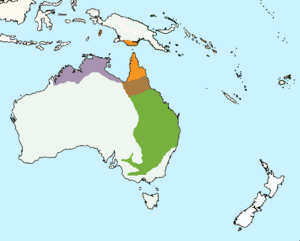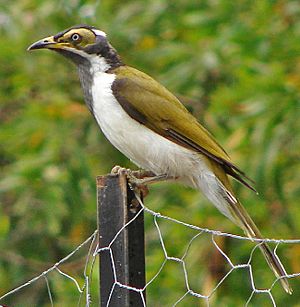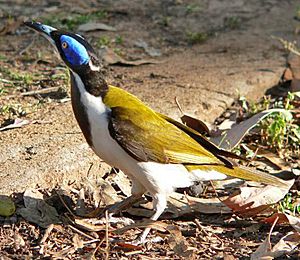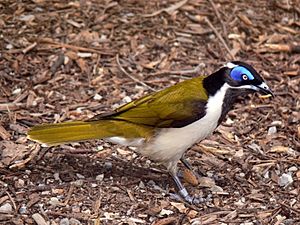Blue-faced honeyeater facts for kids
Quick facts for kids Blue-faced honeyeater |
|||
|---|---|---|---|
 |
|||
| Subspecies cyanotis, Queensland | |||
| Conservation status | |||
| Scientific classification | |||
| Genus: |
Entomyzon
|
||
| Species: |
cyanotis
|
||
 |
|||
| Range subspecies indicated
|
|||
| Synonyms | |||
|
Melithreptus cyanotis |
|||
The blue-faced honeyeater (Entomyzon cyanotis) is a cool bird from the honeyeater family. People sometimes call it the bananabird because it likes to eat bananas! It's the only bird in its group, called Entomyzon. This bird is quite large for a honeyeater, growing to about 29.5 cm (11.6 inches) long.
It has special feathers: olive green on its back, white underneath, and a black head and throat. It also has white patches on its neck and cheeks. Both male and female blue-faced honeyeaters look similar. You can easily tell adults apart from young birds by the bright blue skin around their eyes. Young birds have yellow or green skin around their eyes.
You can find these birds in open woodlands, parks, and gardens. They are common in northern and eastern Australia, and also in southern New Guinea. Blue-faced honeyeaters mostly eat insects, but they also enjoy nectar from flowers and fruit. They often take over old nests built by other birds, like babblers. The female bird lays two or sometimes three eggs and sits on them until they hatch.
Contents
What is a Blue-faced Honeyeater?
The blue-faced honeyeater is a type of passerine bird, which means it's a "perching bird" or "songbird." It belongs to the Meliphagidae family. This family includes many birds that feed on nectar. The blue-faced honeyeater is the only species in its group, called a genus. Its scientific name is Entomyzon cyanotis.
Why is it Called the Bananabird?
One of its fun nicknames is the "bananabird." This name comes from its habit of eating flowers and fruit from banana plants, especially in northern Queensland, Australia. Other common names for this bird include "white-quilled honeyeater" and "blue-eye." Some local names from Indigenous Australian languages include der-ro-gang and gugurruk.
Different Types of Blue-faced Honeyeaters
There are three main types, or subspecies, of the blue-faced honeyeater:
- E. c. albipennis: This type is found in northern Australia, from Queensland to Western Australia. It has white patches on its wings.
- E. c. cyanotis: This is the most common type. It lives from Cape York in Queensland, south through New South Wales, Victoria, and into southeastern South Australia.
- E. c. griseigularis: This smaller type is found in southwestern New Guinea and parts of Cape York.
How to Spot a Blue-faced Honeyeater

This bird is quite large for a honeyeater, usually between 26 and 32 cm (10 to 12.5 inches) long. It weighs about 105 grams (3.7 ounces). It has wide wings with rounded tips and a medium-sized, square tail. Its beak is strong and slightly curved downwards.
The easiest way to recognize an adult blue-faced honeyeater is by the bright blue skin around its eyes. Its head and throat are mostly black, with a white stripe on the back of its neck and another on its cheek. Its back and wings are a golden-olive color, and its belly is white.
Young Blue-faced Honeyeaters
Young birds that have just left the nest look a bit different. They have a grey head, chin, and chest, with brown on their upper parts. Their bare facial skin is yellow. As they get older, the skin around their eyes turns more greenish, then darker blue, until it becomes the bright adult blue by about 16 months of age.
What Do They Sound Like?
Blue-faced honeyeaters make many different sounds. About half an hour before sunrise, they make a piping call that sounds like ki-owt or peet. During the day, they make squeaking sounds when they fly. If they feel threatened, they make harsh squawks. Their calls are deeper than those of some other honeyeaters. They also make soft chirping sounds when talking to their family members.
Where Do Blue-faced Honeyeaters Live?

You can find blue-faced honeyeaters across northern and eastern Australia. Their range stretches from the Kimberleys in Western Australia, across the Northern Territory, and into Queensland. They also live in parts of New South Wales, Victoria, and southeastern South Australia. They can be found from sea level up to about 850 meters (2,800 feet) high. They are also found in southern New Guinea.
These birds usually stay in the same area for a long time. However, in some places, they might move around at different times of the year, but they don't usually migrate long distances like some other birds.
Their Homes and Habitats
Blue-faced honeyeaters live in many different places. They like rainforests, dry sclerophyll forests (which have tough-leaved trees like Eucalyptus), open woodlands, and areas with Pandanus palms. They also live near water, in mangroves, and even in parks, gardens, and golf courses in towns and cities. They are quite adaptable!
How Blue-faced Honeyeaters Behave
Blue-faced honeyeaters are social birds. You often see them in pairs, family groups, or small flocks. Sometimes, they even hang out with other birds like yellow-throated miners. They are known to "mob" or gang up on bigger birds or animals that might be a threat, like owls or goannas.
These birds can be quite noisy when they gather together. When they are feeding in groups, they use soft chirping calls to stay in touch. They also seem to enjoy playing. One bird was even seen playing with a young Australian magpie! Blue-faced honeyeaters also love to bathe. Flocks have been seen diving into pools one by one, then perching in nearby trees to clean their feathers.
Blue-faced Honeyeater Families
Blue-faced honeyeaters probably have babies all over their range. Their breeding season is from June to January. During this time, they might raise one or two groups of chicks.
Nests and Eggs
Their nest is a messy, deep bowl made of sticks and bark. They build it in the fork of a tree, in large ferns, or in Pandanus palms. What's interesting is that they often fix up and use old nests built by other birds! They commonly use nests from babblers, but also from other honeyeaters, magpies, and butcherbirds.
The female bird usually lays two, or sometimes three, eggs. The eggs are about 22 x 32 mm (1 x 1.3 inches) and are pinkish with red-brown or purplish spots. The female sits on the eggs by herself for about 16 or 17 days until they hatch.
Baby Birds
When the chicks hatch, they are blind and have only a few brown feathers. Their eyes open after about four days. Both parents feed the young birds, and sometimes other helper birds join in to help feed them too.
What Do Blue-faced Honeyeaters Eat?
Blue-faced honeyeaters usually look for food in the branches and leaves of trees. They often feed in small groups of up to seven birds. Sometimes, much larger groups of up to 30 birds have been seen feeding together.
Their Diet
Most of their food is insects. This includes cockroaches, termites, grasshoppers, and different types of beetles, flies, moths, bees, ants, and spiders. They catch insects by flying out from a perch to grab them in the air, or by picking them off leaves and bark. In some areas, they like to hunt for insects hidden in the leaves of screw palms.
They also eat plant material like pollen, berries, and nectar from flowers. They particularly like nectar from eucalyptus trees and other native plants. They also enjoy cultivated fruits like bananas and grapes.
These birds can be very curious and friendly. They might even visit campsites looking for food, like fruit, insects, or even leftover jam or honey. They especially love milk! Parent birds feed their young insects, fruit, and nectar, and have even been seen giving them milk.
Blue-faced Honeyeaters in Zoos
You can see blue-faced honeyeaters in several zoos around the world. They are kept at places like Lincoln Park Zoo and Philadelphia Zoo in the United States, Chessington Zoo in England, Edinburgh Zoo in Scotland, and Taronga Zoo in Sydney, Australia.
Images for kids
See also
 In Spanish: Mielero cariazul para niños
In Spanish: Mielero cariazul para niños






